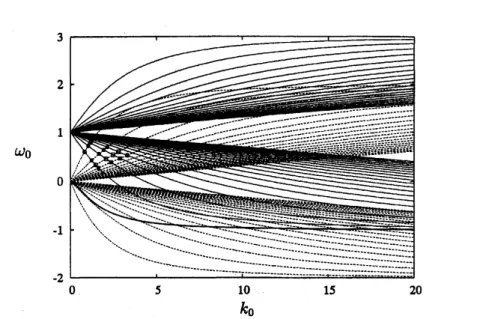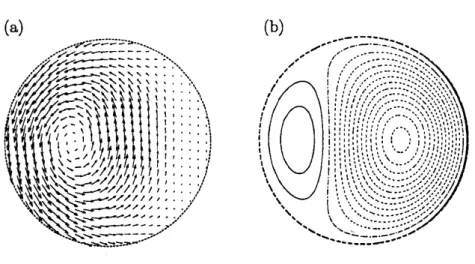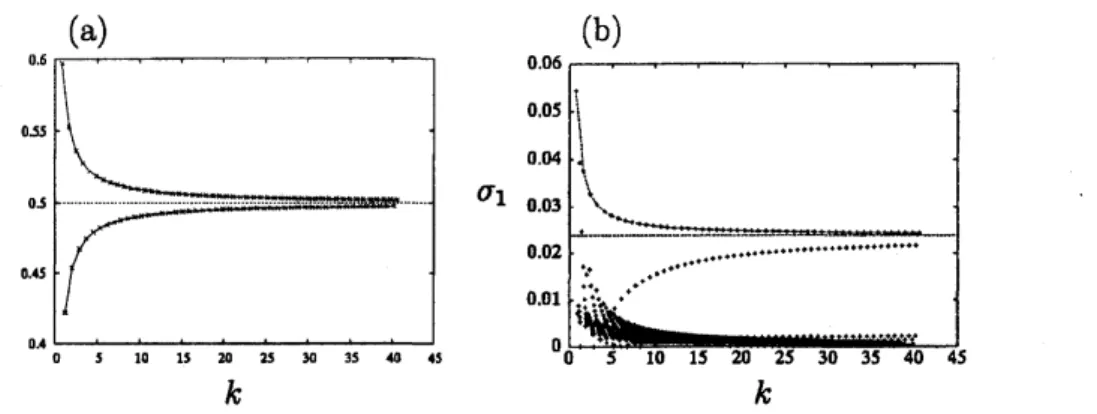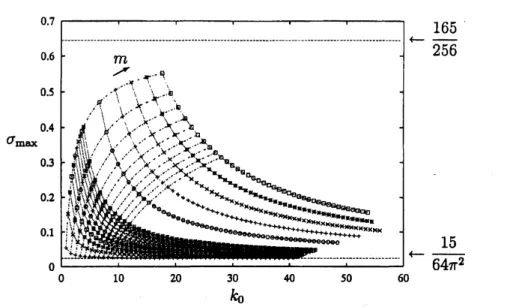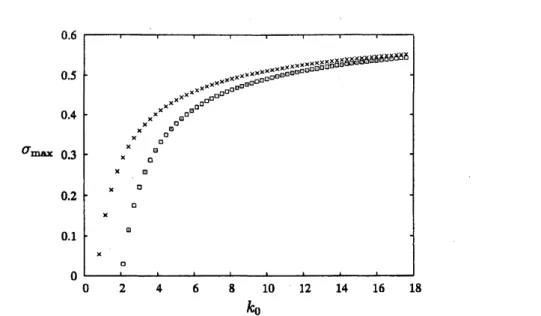143
Curvature
instability
of
a
vortex
ring
九大数理 福本康秀
(Yasuhide Fukumoto)
Graduate
School
of
Mathematics,
Kyushu
Univ
九工大工
服部裕司
(Yuji Hattori)
Faculty
of
Engineering, Kyushu
Institute of
Technology
1
Introduction
Vortex rings
are
invariably susceptible to wavy distortions, leading sometimes to violentwiggles and eventually to disruption. It prevails that the
Moore-Saffman-Tsai-
Widnallinstability, being abbreviated
as
the MSTW instability, is responsible for genesis ofun-stable
waves
(Widnal, Bliss&
Tsai 1974; Moore&
Saffman 1975; Tsai&
Widnall 1976;Widnall
&
Tsai 1977). Remember that this isan
instability fora
straight vortex tubesubjectedto
a
straining field.When viewed locally, athin vortex ring looks like
a
straight tube. For simplicity,we
restrict
our
attentiontothe Rankine vortex, a circularcore
of uniform vorticity. Becauseof circular-cylndrical symmetry, the Rankine vortex is neutrally stable and supports
a
family of three-dimensional waves of infinitesimal amplitude, being well known as the
Kelvin
waves.
The vortex ringinduces,on
itself, not onlya
localuniform flowthat drivesatranslational motion as awhole, but also alocal strainingfield akin toa pure shear, in
themeridionalplane, with principal
axes
tilted by$\pi/4$fromthe symmetric axis (Widnall,Bliss
&
Tsai 1974). This is a quadrupole field proportional to $\cos 2\theta$ and$\sin 2\theta$, in termsof local polar coordinates $(r, \theta)$ inthe meridional plane, with its origin at the
core
centerand with $\theta=0$ along the traveling direction. This field breaks the circular symmetry of
the
core
by deformingit into ellipse, and feeds parametricresonance
between two Kelvinwaves
whoseazimuthal wavenumbers are separated by2 (Moore&
Saffman 1975, Tsai&
Widnall 1976; Eloy
&
Le Dizes 2001; Fukumoto 2003). In the short-wavelength regime,the
MSTW
instabilitycrosses
over
to the elliptical instability foundby Bayly (1986) andWaleffe (1990).
However this might be
a
picture too crude to fit intoa curved
vortex tube. Theasymptotic solution of the Navier-Stokes or the Euler equations for a thin vortex ring
in powers of
a
small parameter $\epsilon$, the ratio of thecore
to the ring radii, starts witha
circular-cylindrical vortextubeat $O(\epsilon^{0})$
.
Avortex ring isfeatured bycurvatureofvortexlines. This feature manifests itself, at $O(\epsilon^{1})$,
as
a
local dipolefield
proportional to $\cos\theta$and $\sin\theta$
.
The quadrupole fieldcomes
merelyas
a
correction at $O(\epsilon^{2})$ (Fukumoto&
Moffatt 2000; Fukumoto 2002). Despite its dominance, the dipole field has not attracted
as
much attentionas
it deserves. This investigation addresses apossible instability whenthe dipole field
comes
into play.144
According to Krein’s theory of parametric
resonance
in Hamiltonian systems (MacKay1986), asingleKelvinwavecannot befedby perturbationsbreakingthe circular symmetry.
An instability becomes permissible only for superpositionof at least two modes with the
same
wavenumber and thesame
frequency. Subjected to the dipole field, two Kelvinwaves
with angular dependence $e^{:}m\theta$ and$e^{*n\theta}$
.
can
cooperativelybe amplified at the intersectionpoints ofdispersion
curves
ifthecondition $|m-n|=1$ is met.A formulation ofthe linear stability analysis
was
fully performed by Widnall&
Tsai(1977), hereinafter being referred to
as
WT77, but the dipoleeffect
hasgone
untouched.Fukumoto
&
Hattori (2002) verified that a combination of the ctisyrnrnetric $(m=0)$and the bending $(n=1)$
waves
indeed leads to parametricresonance.
The localstabilityanalysisof Hattori
&
Fukumoto (2003) disclosedthe existence ofmore
unstableresonance
via the dipole field.
These results stimulate us to exhaust all possible resonant azimuthal-wavenumber
pairs $(m, m+1)$ of Kelvin
waves.
It will be shown that the most dangerous instabilitymode takes place in the limit of $marrow\infty$
.
Contrary to the instability of quadrupole fieldorigin, all ofmultiple eigenvalues do not result in
resonance.
Thenecessary condition forinstability, brought out by Krein’s theory, is either that the eigenvalue collision
occurs
between
a
positive- anda
negative-energy modesor
that the collision eigenvalue iszero.
Energy ofthe Kelvin waves, which
was
calculated by Fukumoto (2003), is instrumentalin making distinction
between
resonant
andnon-resonant
eigenvaluecollisions.
In
\S 2, we
givea
concise description of theproblemsettingforlinear stability analysis.TheKelvin
waves
are
recalled in AppendixA. Section 3seeks the solution ofthe linearizedEuler equations. RemarkablyKelvin’svortex ringadmits
a
closed-form solution, intermsonly of the Bessel and the modified Bessel functions, for the disturbance velocity field,
and
so
is for thegrowth rate and the width ofunstable wavenumber band. The detailedform of solution is relegated to Appendix B. In \S 4, we present anumerical example and
the short-wave asymptotics is dealt with in
\S 5.
The detail is described in Fukumoto
&
Hattori (2004).2
Setting
of linear stability problem
The formulation of the global linear stability analysis in three dimensions
was
made byWT77. We employ its notation.
Kelvin’s vortexringis a thin axisymmetric vortex ring, in an incompressible inviscid
fluid, with vorticityproportional to the distance fromthe axis of symmetry. We
assume
that the ratio $\epsilon$ of
core
rsdius$\sigma$ toring radius $R$ is verysmall:$\epsilon=\sigma/R\ll 1$
.
(2.1)Introducetoroidalcoordinates$(r, \theta, s)$comovingwiththering. Inthe meridional plane
$s=0,$ the origin $r=0$ is maintained at thecenter of thecircular
core
and the angle $\theta$ is145
circle penetrating inside thetoroidal ring is parameterized by the arclength $s$
.
The globalCartesian coordinates $(x, y, z)$
are
then expressed by$x=r\cos\theta$, $y=(R+r\sin\theta)$
co
$\mathrm{s}s$, $z=$ ($R+$$r$sin&)
$\sin s$.
(2.2)Wenormalisetheradial coordinate$r$bythe
core
radius$\sigma$, thevelocitybythemaximumazimuthal velocity $\Gamma/2\pi\sigma$ with $\Gamma$ being the circulation, the time $t$ by $2\pi\sigma^{2}/\Gamma$ and the
pressure by $\rho_{f}(\Gamma/2\pi\sigma)^{2}$ with $\rho_{f}$ being the density of fluid. Let the $r$ and
0
componentsof velocity fieldbe $U$ and $V$, respectively, and the pressure be$P$ inside the
core
$(r<1)$.
The velocity potential for the exterior irrotational flow is denotedby $\Phi$
.
The basic flow is expanded in powers of $\epsilon$, the first-0rder truncation of which takes
theform:
$U=\epsilon U_{1}(r, \theta)+\cdot$
..
’ $V=V_{0}(r)+\epsilon V_{1}(r, \theta)+\cdots$ ,
$P=P_{0}(r)+\epsilon P_{1}(r, \theta)+\cdots$ for $r<1$, (2.3)
$\Phi=\Phi_{0}(\theta)$$+$$\epsilon\Phi_{1}(r,\theta)+\cdots$ for $r>1$
.
(2.4)The leading-0rderflow is the Rankine vortex
as
expressed, in dimensionless form, by$V_{0}=r$, $P_{0}=|$ $(r^{2}-1)$
,
$\Phi_{0}=\theta$.
(2.2)The first-0rder flow field isadipole field:
$U_{1}$ $=$ $\frac{5}{8}(1-r^{2})\cos\theta$ , $V_{1}=(- \frac{5}{8}+$$\mathrm{q}r2)$$\sin\theta$, $P_{1}---(- \frac{5}{8}r+\frac{3}{8}r^{3})\sin\theta$, $\Phi_{1}$ $=$
(
$\frac{1}{8}r-\frac{3}{8r}-$ $1^{r}$$\log r$)
$\cos\theta$.
(2.6)To this order circular form of
core
boundary $(r=1)$ remains intact.We
inquire into evolution ofthree- imensional
disturbancesof infinitesimal
amplitudesuperposed
on
the above steady flow. Following the prescription of Moore&
Saffman(1975) and Tsai
&
Widnall (1976),we
expandthe disturbance velocity$\tilde{v}$, the disturbancepressure$\tilde{p}$and the external disturbancevelocity-potential
$\overline{\phi}$in powers of
$\epsilon$to firstorder
$\tilde{v}={\rm Re}[(v_{0}+\epsilon v_{1}+\cdots)e^{:(\mathrm{k}s-\mathrm{I}dt)}]$ , $\tilde{p}={\rm Re}[(\pi_{0}+\epsilon\pi_{1}+\cdots)e"‘]\mathrm{k},-\omega)$ ,
$\tilde{\phi}={\rm Re}[(\phi_{0}+\epsilon\phi_{1}+\cdots)e" \mathrm{k}" t)]$, (2.7)
wherethe symbol${\rm Re}$designatesthe real part. In keepingwiththis form, the wavenumber
$k$ and the frequency $\omega$, nondimensionalised by $1/\sigma$ and $\Gamma/(2\pi\sigma^{2})$ respectively,
are
alsoexpanded
as
$k=k_{0}+\epsilon k_{1}+\cdots$ : $tt$ $=\omega_{0}+\epsilon\omega_{1}+\cdot\cdot\iota$ (2.8)
Thedisturbed edge of the
core
is expandedas
146
3
Effect of
dipole field
The flow fieldVo, $\pi_{0}$ and $\phi_{0}$ and the dispersion relation$\omega_{0}$ $=\omega_{0}(k_{0})$ of Kelvin
waves
are
accommodated in Appendix A (see, for example, Saff
man
1992; Fukumoto 2003). Ourconcern
lies in the modification ofKelvin’s dispersion relationdue tosymmetry-breakingaction of the $O(\epsilon)$ dipolefield.
3.1
Governing equations
Wedenotethetoroidal component of disturbance velocity by$\mathrm{J}\mathrm{j}\mathrm{F}$
.
The amplitude vector$v_{1}$ofdisturbancevelocityand the amplitude$\pi_{1}$ofdisturbancepressureof$O(\epsilon)$
are
governed,inside the
core
$(r<1)$, by$-\mathrm{i}_{\mathrm{W}(0}u_{1}$ $+ \frac{\partial u_{1}}{\partial r}-2v_{1}+\frac{\partial\pi_{1}}{\partial r}=(i\omega_{1}-\frac{\partial U_{1}}{\partial r})u_{0}-U_{1}\frac{\partial u_{0}}{\partial r}-\frac{V_{1}}{r}\frac{\partial u_{0}}{\partial\theta}-(\frac{1}{r}\frac{\partial U_{1}}{\partial\theta}-\frac{2V_{1}}{r})v_{0}$,
(3.1)
$-i \omega_{0}v1+2u_{1}+\frac{\partial v_{1}}{\partial\theta}+\frac{1}{r}\frac{\partial\pi_{1}}{\partial\theta}=(i\omega_{1}-\frac{1}{r}\frac{\partial V_{1}}{\partial\theta}-\frac{U_{1}}{r}$
)
$v_{0}-$ $( \frac{\partial V_{1}}{\partial r}+\frac{V_{1}}{r}$)
$u_{0}$$-U_{1}$$\frac{\partial v_{0}}{\partial r}-\frac{V_{1}}{r}\frac{\partial v_{0}}{\partial\theta}$ , (3.2)
$-i\omega$70111 $+ \frac{\partial w_{1}}{\partial\theta}+ik_{07}\mathrm{r}_{1}$$=-ik_{1^{7\mathrm{i}}0}$$+(i \omega_{1}-r\cos\theta)w_{0}-\frac{V_{1}}{r}\frac{\partial w_{0}}{\partial\theta}-U_{1}\frac{\partial w_{0}}{\partial r}+iA_{0}\tau$ $\sin\theta\pi_{0}$ ,
(3.3)
$\frac{\partial u_{1}}{\partial r}+\frac{u_{1}}{r}+\frac{1}{r}\frac{\partial v_{1}}{\partial\theta}+ik_{0}w_{1}=-\sin\theta u_{0}-\cos\theta v_{0}+ik_{0}r\sin\theta w_{0}$
.
(3.1)The last
one
istheequationofcontinuity. The amplitudefunction$\phi_{1}$ ofvelocity potentialforthe disturbance flow of $O(\epsilon)$
,
outside thecore
$(r>1)$,
satisfies$\frac{\partial^{2}\phi_{1}}{\partial r^{2}}+\frac{1}{r}\frac{\partial\phi_{1}}{\partial r}+\frac{1}{r^{2}}\frac{\partial^{2}\phi_{1}}{\partial r^{2}}-k_{0}^{2}\phi_{1}=2k_{0}k_{1}\phi_{0}-\sin\theta\frac{\partial\phi_{0}}{\partial r}-\frac{\cos\theta}{r}\frac{\partial\phi_{0}}{\partial\theta}-2k_{0}^{2}r\sin\theta\phi_{0}(.3.5)$
The boundary conditions require that the normal componentofvelocityand the
pres-sure
be continuousacross
the interface $(r=1)$ of thecore:
$u_{1}$ $=$
$\frac{\partial\phi_{1}}{\partial r}$ ,
$\pi_{1}-$
iu0
$5_{1}+ \frac{\partial\phi_{1}}{\partial\theta}$ $=$ $i_{\mathrm{I}} \omega_{1}6_{0}-\frac{\partial\Phi_{1}}{\partial\theta}\frac{\partial\phi_{0}}{\partial\theta}$.
(3.6)The shape ofdisturbed
core
boundary is found from147
The right-hand sides of (3.1)-(3.7) include the coupling of Kelvin
waves
with thedipole field (2.6) of $O(\epsilon)$. We delineate WT77’s formulation,
as
generalised to higherazimuthal-wavenumber
resonance.
Suppose that a pair of Kelvin waves whose azimuthal wavenumbers differ by 1 are
simultaneously sent to $O(\epsilon^{0})$:
$v_{0}=v_{0}^{(1)}e^{im\theta}+v_{0}^{(2)}e^{\dot{|}(m+1)\theta}$ (3.8)
Here and hereafter, we make use ofsuperscripts of(1) and (2) for the $m$ and the $mf$$1$
waves respectively. In view of the dipole field
on
the right-hand sides of (3.1)-(3.5) andtheboundaryconditions (3.6), thewave excited at $O(\epsilon)$ is found to possess the following
angular dependence:
$v_{1}=v\mathrm{i}^{\mathrm{D}}e^{\mathrm{j}}m\theta$ $+v_{1}^{(2)}$
e.
$\cdot$
$(m+1)\theta+v_{1}^{(3)}e^{:(m-}1)0$ $+v_{1}^{(4)}e^{i(m+2)\theta}$ (3.9)
The similar form is posed on $\pi_{0},$ /0 and $\pi_{1}$,$\phi_{1}$
.
Excitation, at $O(\epsilon)$, ofa
pair ofwaves
with the
same
azimuthal wavenumbersas
at $O(\epsilon^{0})$ impliesa
possibility of parametricresonance.
Theleading-0rder disturbance is, from Appendix$\mathrm{A}$,
$\phi_{0}=$ $K_{m}(A_{0}r)\alpha_{0}^{(1)}e^{\dot{|}m\theta}+K_{m+1}(A_{0}r)\alpha_{0}^{(2)}e^{(m+1)\theta}.\cdot$,
$\pi_{0}$ $=$ $J_{m}(\eta_{1}r)\beta_{0}^{(1)}e^{m\theta}\dot{.}+J_{m+1}(\eta_{2}r)\beta_{0}^{(2)}e^{(m+1)\theta}\dot{.}$: (3.10)
where $J_{m}$ and$K_{m}$ are, respectively, the Bessel function of the first kind and the modified
Bessel function of the second kind, $m$ being their order, $\alpha_{0}^{(1)}$, $\alpha_{0}^{(2)}$, $\beta_{0}^{(1)}$ and $69^{2)}$ are
constants, and $\eta_{1}$ and $\eta_{2}$
are
the radial wavenumbers of the $m$ and the $m+1$waves
respectivelyas defined by (A.4) and (A.5). Likewise, the interior velocity field $(u_{0}, v_{0}, w_{0})$
is expressible
as
superposition of the expressions (A.3) for the $m$ and $m+1$waves.
Upon substituting from (3.10), (3.5) is integrated to yield
$\phi_{1}^{(1)}$ $=K_{m}(A_{0}r)\alpha_{1}^{(1)}-k_{1}rK_{m+1}(A_{0}r)\alpha_{0}^{(1)}$
$+ \frac{i}{4}\{A_{0}r^{2}K_{m}(A_{0}r)+(2m+1)rK_{m+1}(k_{0}r)\}\alpha_{0:}^{(2)}$ (3.11)
$\phi_{1}^{(2)}$
$=$ $K_{m+1}(k_{0}r)\alpha_{1}^{(2)}-k_{1}rK_{m}(A_{0}r)\alpha_{0}^{(2)}$
$+ \frac{i}{4}\{(2m+1)rK_{m}(k_{0}r)-k_{0}r^{2}K_{m+1}(A_{0}r)\}\alpha_{0}^{(1)}$, (3.12)
where $\alpha)^{1)}$ and $\alpha_{1}^{(2)}$ areconstants imparted to the homogeneous parts of solution.
Analytical handlingofthe interior field becomes feasible by collapsing (3.1)-(3.4), at
the outset, to second-0rder ordinary differential equations for the disturbance pressure
$\pi_{1}^{(1)}$
are
$\pi_{1}^{(2)}$.
Aftersome
computer algebra, weare
left with$L^{(1)}[ \pi_{1}^{(1)}]=\{\frac{8k_{0}^{2}\omega_{1}}{(\omega_{0}-m)^{3}}-\frac{2A_{1}}{k_{0}}\eta$
r
$\}J_{m}(\eta_{1}r)\beta_{0}^{(1)}-i\{[$ $\frac{1}{2}+\frac{3m}{2(\omega_{0}-m-1)}$ $- \frac{5k_{0}^{2}}{4}(\frac{1}{(\omega_{0}-m)^{2}}-\frac{1}{(\omega_{0}-m-1)^{2}})(r^{2}-1)]\eta_{2}J_{m}(\eta_{2}r)$148
$L^{(2)}[ \pi_{1}^{(2)}]=\{\frac{8k_{0}^{2}\omega_{1}}{(\omega_{0}-m-1)^{3}}-\frac{2k_{1}}{k_{0}}\eta_{2}^{2}\}J_{m\mathit{6}1}$ ” $( \eta_{2}r)\beta_{0}^{(2)}+\frac{i}{4}\{[$$4+ \frac{71v_{0}-9m+10}{(\omega_{0}-\sqrt)^{2}}$ $- \frac{2(8\omega_{0}-9m-8)}{(\omega_{0}-m-1)^{2}}]k_{0}^{2}rJ_{m}(\eta_{2}r)-[2+\frac{6(m+1)}{\omega_{0}-m-2}$ $+5k_{0}^{2}( \frac{1}{(\omega_{0}-m)^{2}}-\frac{1}{(\omega_{0}-m-1)^{2}})(r^{2}-1)\mathrm{I}\eta_{1}J_{m+}1(\eta_{1}r)\}\beta_{0}^{(1)}$ , (3.14) where $L^{(*)}.= \frac{d^{2}}{dr^{2}}+\frac{1}{r}\frac{d}{dr}-\frac{m_{1}^{2}}{r^{2}}$ . $+\eta_{\dot{l}}^{2}$ $(i=1,2)$.
(3.13)Theboundaryconditions (3.6) read, for the $m$wave,
(1) $\partial\phi_{1}^{(1)}$
$u_{1}$ $-\overline{\partial r}=0$
,
$\pi_{1}^{(1)}-i(\omega_{0} -m)\phi_{1}^{(1)}=i\mathrm{r}\omega 1\phi_{0}^{(1)}+\frac{m+1}{8}\phi_{0}^{(2)}$ , (3.16)and, for the$m+1$ wave,
(2) $\partial\phi_{1}^{(\mathit{2})}$
$u_{1}$ $-\overline{\partial r}=0$
,
$\pi_{1}^{(2)}-i(\omega_{0}-m-1)\phi_{1}^{(2)}=i\omega_{1}\phi_{0}^{(2)}-\frac{m}{8}\mathrm{p}6^{1)}$ (3.17)3.2
Disturbance field and
growth
rate
WT77 skipped the solution for$v_{1}$
.
We arenow
ready to build the solution of (3.13) and(3.14) and to calculate the $O(\epsilon)$ correction$\omega_{1}$ to the eigenfrequency from the boundary
conditions (3.16) and (3.17).
Byappealingto symbolic calculus, Mathematica say, thesolution of (3.13) and (3.14)
isobtained inclosedform solelyintermsof the Bessel functions. The resultingexpressions
for $\pi_{1}^{(1)}$, $\pi_{1}^{(2)}$, $u_{1}^{(1)}$ and $u_{1}^{(2)}$, the enforcement of the boundary conditions (3.16)
and
(3.17)and thesolvability conditions
on
themare
written down in Appendix B.We
recapitulatethe procedure ofMoore
&
Saffman(1975) andTsai&
Widnall(1976).Simultaneous excitation of at least two Kelvin
waves
is requisite for instability, beingindicative ofparametric
resonance.
Thepostulation that the solvability conditions (B.7)and (B.8) have
a
nontrivial solution of$\beta_{0}^{(1)}7$ $0$ and $\beta_{0}^{(2)}\neq 0$ gives rise to$\omega_{1}$
.
Instabilityis implied when ${\rm Im}[\omega_{1}]>0$ and
we
write its growth rateas
$\sigma_{1}=|{\rm Im}[\mathrm{c}\mathrm{i}_{1}]|$.
Incase
of instability, the growth rate takes its local maximum value $\sigma_{1\max}$ at $k=A_{0}$, namely
$k_{1}=0,$ and ${\rm Im}[\omega_{1}]>0$ only
over
a limited wavenumber range of width $2\epsilon\Delta k_{1}$ centeredon
$k=k_{0}$.
The desired formulae of$\sigma_{1\max}$ and $\Delta k_{1}$are
gainedfrom (B.7) and (B.8)as
$\sigma_{1\max}^{2}=$ $- \frac{(\omega_{0}-m)^{3}(\omega_{0}-m-1)^{3}(\omega_{0}-m+1)(\omega_{0}-m+2)(\omega_{0}-m-2)(\omega_{0}-m-3)}{1024A_{0}^{4}(2\omega_{0}-2m-1)^{4}}$
$\mathrm{x}\frac{h^{2}}{f^{(1)}f^{(2)}}$ , (3.18)
$\Delta k_{1}^{2}$ $=$ $- \frac{(\omega_{0}-m)^{3}(\omega_{0}-m-1)^{3}(\omega_{0}-m+1)(\omega_{0}-m+2)(\omega_{0}-m-2)(\omega_{0}-m-3)}{1024A_{0}^{2}(2\omega_{0}-2m-1)^{4}}$
149
where
$d=$ $(\omega_{0}-m)\mathrm{C}’ 0-m+2)(\omega_{0}-m-2)f^{(2)}g^{(1)}$
$-(\omega_{0}-m-1)(\omega_{0}-m+1)(\omega_{0}-m-3)f^{(1\rangle}g^{(2)}$ , (3.20)
and the form of$f^{(1)}$, $f^{(2)}$, $g^{(1)}$, $g^{(2)}$ and $h$ is providedby $(\mathrm{B}.9)-(\mathrm{B}.13)$
.
4
Example
4.1
Resonance
between the 0,
1
waves
Togive
an
illustration,we
carry throughnumericalcomputation ofstabilitycharacteristicsfor the copling between the axisymmetric $(m=0)$ and the bending $(m=1)$
waves.
Thedispersion relation of Kelvin waves of$m=0$ (dashed lines) and $m=1$ (solid lines) is
displayed in figure 1. The isolated branchof$m=1,$startingfrom$\omega_{0}=0,$ isdrawnwitha
thick solidline. Infinitelymanybranchesemanatefrom $(k_{0}, \omega_{0})=$ $(0, 1)$ for$m=1$ among
which twenty branches, ten upgoing and ten downgoing, are drawn. Theses modes
are
named the radial modes since the eigenfunctions have nontrivial radial nodal structure.
A wave with $|\omega_{0}|>1$ rotatesfaster than the basic circulatory flow and iscalled
a
cogrademode,which isdistinguished from
a
wave
with$|\omega_{0}|<1,$aretrogrademode (Sdman 1992).In contrast,
an
isolated branch and the counterpart ofretrograde modesare
missing forthe axisymmetric mode. Given the wavenumber $k_{0}$, the modes with $\omega_{0}$ and with $-?!0$
share
a
common
property ofcograde radial mode.A positive axisymmetric mode $(\omega_{0}>0)$
crosses
every retrograde modeof$m=1$ once,andmay cross, twice,
some
of higher cogradebranches of$m=1.$ Anegative axisymmetricmode $(\omega_{0}<0)$ collides, ifitsbranch index is high enough, with some of retrograde radial
modes of$m=1,$ twice per each. The isolated mode of $m=1$
crosses
branches of$m=0$at smallvalues of$k_{0}$
.
The growth rate (3.18) is calculated at many of intersection points. Collision of
eigen-values of the 0,1
waves
does not necessarily result in instability. Stability is lost only atintersection points between positive branches of $m=0$ and retrograde radial modes of
$m=1,$ andotherwise this isnotthe
case.
This behaviour lies in starkcontrast with thatof the MSTW instability. In the latter case, every eigenvalue collision invites
paramet-ric
resonance
(Eloy&
Le Dies 2001; Fukumoto 2003). The energetics holds the key todistinguish non-resonant collisions from resonant ones,
as
will be described in\S 4.3.
In Table 1,
we
list the evaluated values of the growth rate and the unstableband-width for lowwavenumbers. The
first
threerows
correspondto thefirstthree intersectionpoints ofthe first positive axisymmetric mode $(m=0)$ with retrograderadial modes of
$m$$=1,$ and
are
markedwith circles in figure 1. The next threerows are
alongthesecondmode of$m=0$ (thick dotes), and thelastthree along the third mode of$m=0$ (squares).
Sincethetorus center is
a
circleof radius $R$,an
unstablemode isrealizableonlywhenthearclength $2\pi R$ coincides with
some
integral multiple of a half ofthe wavelength $2\pi/h$.
150
$\omega_{0}$
Figure 1: Dispersion relation of the axisymmetric
wave
$m=0$ (dashed lines) and thehelical
wave
$m=1$ (solid lines)on
the Rankine vortex. The isolated branch of$m=1$ isshown with
a thidc
line.$k_{0}$ $\omega_{0}$ $\sigma_{1\max}$ $\Delta k_{1}$
0.8134868347 0.5970895378 0.05434123370
0.1022075453
1.018687659
0.7162537484 0.007063858086
0.01725321243 1.136862167 0.7794574187 0.0086760953660.02449637577
1.2245056200.4217998862 0.03931853915
0.10930804151.650449151
0.5528357882 0.03769686682
0.1381880078
1.927505750
0.6329096309
0.004366456551 0.01889368333
1.4645728740.3290672352 0.02466638188
0.08406115354
2.059092345
0.4537065585 0.01547299060
0.07032354299
2.472533079 0.53640309380.03273541819
0.1773468081
Table 1: Themaximumgrowth rate$\epsilon\sigma_{1\max}$ andthehalf-wi th$\epsilon\Delta k_{1}$ of unstable
151
$(\begin{array}{l}\prime\prime\nearrow\mathit{1}\acute{l}\prime.J’\prime\prime j’JJ\prime|.\mathrm{i}\iota_{}\mathrm{i}\mathrm{i}\mathrm{O}\mathrm{o}\end{array}.\backslash |’---\sim\backslash \backslash \backslash \backslash \backslash _{1}|’l..\backslash ‘ 3\mathrm{S}_{\iota_{\mathfrak{l}_{1}}}$
$\mathrm{i}\mathrm{i}\mathrm{i}_{\mathrm{I}}\mathrm{i}\mathrm{I}||...\backslash ..\cdot J^{\acute{\prime}}\backslash |)$ $.\iota_{\backslash }$
$\backslash \mathrm{j}_{\nwarrow_{\backslash }^{\backslash \mathit{1}^{j}}}^{\backslash }[searrow]^{\backslash }\mathrm{S}_{\backslash }\mathrm{i}\backslash \sim_{--\sim}^{\backslash }\backslash \sim_{\vee\cdot---}\cdot-’$ \prime\prime\prime
’/
Figure 2: Contour ofdisturbance toroidal velocityfield$w_{0}$
on
the meridional plane$hs$ $=$$\omega_{0}t$ for the first principal mode of the $(0, 1)$
resonance.
The dashed line depicts thecore
boundary$r=1.$
Large growth rate is maintained to short wavelengths at intersection points between
the $i$-th branch of $m=0$ andthe $i$-th branch of the retrograde radial modes of $m=1.$
Thissequence belongsto what wecall the principalmodes. The origin $(k_{0},\omega_{0})=(0,0)$is
the intersection point between the isolated branch of$m=1$ and all branches of $m=0.$
This is considered to be
a
neutrally stable point (Pukumoto&
Hattori2004).Amongtheintersection points examinedsofar,the maximum of growthrateisattained
at the first principal mode, namely at $(k_{0},\omega_{0})\approx$ (0.8134868347, 0.5970895378), though
the maximum value $\sigma_{1\mathrm{m}\mathrm{a}\mathrm{e}\mathrm{c}}\approx 0.05434123370$ is not very large. The correspon $\mathrm{i}\mathrm{g}$ flow
field is calculated, to $o(\epsilon^{0})$, from (3.8) with $v_{0}^{(1)}$ and $v_{0}^{(2}$) provided in Appendix A. The
solvability conditions bring in$\beta_{0}^{(2)}/\beta_{0}^{(1)}\approx$
0.7276318666
at this point.The contour of toroidal velocity $w_{0}$ on the crosssectionalplane $k_{0}s=\omega_{0}t$ is drawn in
figure 2. Only the interior region $(r<1)$ is shown. A strong toroidal or axial current
is induced
over a
massive region with the location of peak velocity deviated backwardffom the
core
center, and is accompanied bya
minor counter current in the front partofthe core. The location of peak velocity winds helically around the torus center, and
executes
a
circulatory motion around the center. Figure $3(\mathrm{a})$ displays the disturbancevorticity field $(\omega_{0r},\omega_{0\theta})$ of$O(\epsilon^{0})$ projected to the
same
crosssectional plane. The contouroftoroidal vorticity$\omega_{0s}$ is shown in figure$3(\mathrm{b})$
.
The ring-lke vorticitystructure in figure$3(\mathrm{a})$ corresponds to strong toroidal flow in figure 2. The toroidal vorticity is large at
points where the toroidal current is week.
We
reason
that,as
withthecases
ofthe elliptical instability (Waleffe 1990) and of theinstability due to multi-polar strain (Eloy
&
Le Dizes 2001), the instability mechanismis attributable to parallelization between the stretching direction of local shear and the
152
$1\{|$
(a) (b)
$.\neg.\sim\backslash -\approx..\simeq.*\sim$
Figure3: Disturbancevorticityfield in the meridional plane$k_{0}s=\omega_{0}t$of the firstprincipal
mode of the $(0, 1)$ resonance, (a) The meridional components $(\iota v_{0r},\omega_{0\theta})$
.
(b)Contour
ofdisturbance toroidal vorticityfield$\omega_{0s}$. The dashedline depicts the
core
boundary$r=1.$function
of
angles between the disturbance vorticity vector and the eigenvectors of therate of strain for the first principal mode at $(k_{0},\omega_{0})\approx$ (0.8134868347, 0.5970895378).
Tendency ofalignment ofthe vorticityvector
was
recognized only with the unit toroidalvector. It follows that vortex-line stretching in the toroidal direction plays the leading
role ofdriving instability.
The magnitudeofstrain increases with the distance $r$ from the
core
center and takesits maximum at the
core
boundary $r=1.$ In the geometric-0ptics approximation, thegrowth rate for the wave-packet disturbance of short wavelength attains its maximum
on the streamline circuiting the edge of the core (Hattori
&
Pukumoto 2003). In theshort-wave limit, onlythe disturbance vorticity
near
thecore
boundary isrelevant tothegrowthrate.
Thegrowthrate of theprincipalmodes diminishes
as
the branch labelbecomes larger.Calculation of intersection points of the dispersion
curves
and of the growth rateat
thepoints is
extended
to largewavenumbers
and isplottedin figure4. Thegrowthratestaysat relatively large values, approaching $\sigma_{1\max}\approx$ 0.02374715242, along the two sequences
of intersection points rapidly converging to $\omega_{0}=0.5$ (figure $4(\mathrm{a})$). One sequence is
intersection points between the $i$-th cograde mode of $m=0$ and the $i$-th retrograde
mode of$m=1$ forwhich the growth ratemonotonicallydecreases with$k_{0}$, andthe other
sequence is a collection of intersection points between the $(i+1)$-th cograde mode of
$m=0$ and the $i$-th retrograde mode of$m=1$ for which the growth rate is, except for
a
first few intersection points, an increasing function of $k_{0}$
.
Eloy&
Le Dizes (2001) calledthe latter the principal modes. We include both into the principal modes.
Inorderto graspoverall instabilitycharacteristics in the $(A_{0},\{v_{0})$ space, calculation of
153
$\omega_{0}$ $\mathrm{D}4_{\lambda^{\iota}}^{\iota_{\mathfrak{i}}}....\ovalbox{\tt\small REJECT} 9$ \
$\backslash .\cdot.\cdot\cdot..\ldots 2^{\cdot}0s$
.
$\mathrm{a}$.
....
$k$ $k$
Figure 4: Large wavenumber behaviour of the $(0, 1)$ resonance, (a) The intersection
points $(k_{0},\iota v_{0})$ ofthe dispersion curves, (b) The maximum growth rate $\sigma_{1\max}$
.
over a
widerange
of $k_{0}$ and $m$.
The growth rate is plotted in figure5. The modes
of$m=1,2$,$\cdots$,10 and 20, 30,$\cdots$,60
are
shown.Given
$m$, the growthrate
of $(m, m+1)$resonance
decreases with the branch labelor
the wavenumber $k_{0}$ and tends to $\sigma_{1\max}\approx$0.02374715242 as
$k_{0}arrow\infty$.
Onthe other hand, given the branch label, the growth rateincreases monotonicaUy with $m$ and approaches $\sigma_{1-}=$ 0.64453125
as
$marrow\infty$. Theways ofapproachto thetwo different short-wave limits will be expounded in
\S 5.
4.2
Energetics
Krein’s theory of Hamiltonian spectra underlies the preceding numerical results. A
nec-essary conditionfor loss of stability at
a
double eigenvalue is either that the eigenfunctionconsists of
waves
with opposite signed energyor
that the eigenvalue is 0 (MacKay 1986;Dellnitz, Melbourne
&
Marsden 1992; Knobloch, Mahalov&
Marsden 1994).By taking advantage of Cairns’ formula (Cairns 1979), Fukumoto (2003) reached
a
tidy expression for energy required to excite the Kelvin
wave
of azimuthal wavenumber$m$
as
$E= \frac{2\pi\omega_{0}}{\omega_{0}-m}\{1+\frac{(k_{0}/\eta_{1})^{2}K_{|m|}(b)}{k_{0}K_{|m|-1}(k_{0})+|m|K_{|m|}(k_{0})}[$$\frac{2(\omega_{0}+\sqrt)}{\omega_{0}-m}$
$+( \frac{m(\omega_{0}+m)}{2}+k_{0}^{2}$
)
$\frac{K_{|m|}(k_{0})}{k_{0}K_{|m|-1}(k_{0})+|m|K_{|m|}(k_{0})}]\}(f_{0}^{(1)})^{2}$ : (4.1)where $f_{0}^{(1)}$ is the displacement amplitude ofthe disturbed
core
$r=1+f_{0}^{(1)}\exp[i(m\theta+$$k_{0}z-\omega_{0}t)]$, and is linkedto the amplitude
56))
ofthe disturbance pressure through $f_{0}^{(1\rangle}= \frac{1}{4-(\omega_{0}-m)^{2}}\{-\eta_{m}J_{|m|-1}(\eta_{m})+\frac{|m|}{(v_{0}-m}(\omega_{0}-$rn
$+ \frac{2m}{|m|}$)
$J_{|m|}(\eta_{m})\}\beta_{0}^{(1)}$ (4.2)By
a
computationof the above formula,we
find thatthe energy of the axisymmetric154
$A_{0}$
Figure 5: The growth rate of the principal modes between the $i$-th cogrademodes
of
$m$wave
and the$i$-thretrogrademodes of$m+1$wave.
Thesame
symbol isusedfor
thesame
azimuthalwavenumber pair $(m, m+ 1)$
.
The lowestsequence $(+)$ correspondsto$m=0.$The highest sequence (0) correspondsto $m=60.$
energy
as
the$i$-th branch ofpositive mode. Theenergy of thebendingwave
$(m=1)$was
illustrated in figure 8 of Fukumoto (2003). The energy of the isolated mode and cograde
radial modes of $m=1$ is positive
over
the entire range of $k_{0}$, and thereforeresonance
with the $m=0$ mode is ruled out. As is evident from (4.1), alteration of energy sign
occurs
at the point, $k_{0}^{*}$ say, where a dispersioncurve crosses
the $k_{0}$ axis. The energy ofretrograde radial modes of$m=1$ is negative intherange$0<k_{0}<k_{0}^{*}$, and is positive for
$t_{0}>I?.$ Eigenvaluecollisions of negative- and positive
energy
modesoccur
onlybetweenretrograde radial modes of $m=1$ and upgoing modes of $m=0$ in frequency
range
of$0<\omega_{0}<1,$ being in
no contradiction
with the numerical example of\S 4.1.
Krein’s criterion by
means
of theenergy
signature furnishes merelya
necessarycon-dition for instability, yet it in effect
serves as a
sufficient condition for instabilityas
well.The
same
is true of the MSTW instability (Pukumoto 2003).5
Short-wavelength
asymptotics
The expression (3.18) of growth rate suggests that
a
resonance
pair with $\omega_{0}$ closer to$m+1/2$ is
more
influential. A universal feature manifests itself in the short wavelengthlimit in which $\omega_{0}$ converges to $m+1/2$
.
Herewe
omit thederivation. Thedetail is foundin Fukumoto
&
Hattori (2004).We have two wavelengths at
our
disposal, namely, theaxial and theazimuthal155
azimuthal structure by fixing$m$, andthereafter
we
turnto the limit of$marrow\infty$.5.1
Large
$k_{0}$with
m
fixed
Let $l_{1}$ and$l_{2}$ be large integers indexing branches of the$m$and the$m+1$wavesrespectively
as
$A_{0}$ with $m$ fixed. Define$\Delta l=l_{2}-l_{1\prime}$ $\Delta’l=2\Delta l-1$
.
(5.1)Asymptotic expansions of $(k_{0},\omega_{0})$ for degenerate eigenvalues of the $m$,$m+1$
waves
aremanipulated from the dispersionrelation (A.7) and the counterpart of$m+$l. The
inter-section frequency is
$\omega_{0}=m+\frac{1}{2}+\frac{\sqrt{15}\pi\Delta’l}{128k_{0}}-\frac{1}{128A_{0}^{2}}\{m+\frac{1}{2}+\frac{\sqrt{15}\pi\Delta’l}{16}\}+O(A_{0}^{-3})$
.
(5.2)The intersection wavenumber is obtained by solving iteratively
$k_{0}$ $=$ $\frac{1}{\sqrt{15}}\{\frac{\pi(l_{1}+l_{2}+m-1)}{2}+$$\arctan$ $( \frac{1}{\sqrt{15}})\mathrm{t}$ $- \frac{1}{30k_{0}}\{m^{2}+m+1+\frac{29\pi^{2}(\Delta’l)^{2}}{256}\}$
$+O(k_{0}^{-2})$
.
(5.3)Substitutingfrom (5.2), (3.18) and (3.19) give,
$\sigma_{1\max}$ $=$ $\frac{15}{64\pi^{2}(\Delta’l)^{2}}+\frac{\sqrt{15}}{32k_{0}}\{\frac{m}{\pi\Delta’l}[\frac{21}{8}+\frac{1}{\pi^{2}(\Delta l)^{2}},]+\frac{1}{2}[$ $- \frac{9\sqrt{15}}{64}+\frac{21}{8\pi\Delta l}$
,
$+ \frac{\sqrt{15}}{16\pi^{2}(\Delta l)^{2}},+\frac{1}{\pi^{3}(\Delta l)^{3}},]\}+O(k_{0}^{-2})$ ,$\Delta k_{1}$ $=$ $\frac{A_{0}}{2\pi^{2}(\Delta l)^{2}},+\frac{m}{\sqrt{15}\pi\Delta’l}[\frac{21}{8}+\frac{1}{\pi^{2}(\Delta l)^{2}},]+\frac{1}{2\sqrt{15}}[-\frac{\mathrm{g}\sqrt{15}}{64}+\frac{21}{8\pi\Delta l}$
,
$+ \frac{\sqrt{15}}{8\pi^{2}(\Delta l)^{2}},+\frac{1}{\pi^{3}(\Delta l)^{3}},]+O(k_{0}^{-1})$.
(5.4)Finite value $15/(64\pi^{2}(\Delta’l)^{2})$ of the growth rate is asymptoted in the limit of $A_{0}arrow$
$\infty$, among which the modes specified by $\Delta l=0$ and 1 have the largest growth rate
$15/(64\pi^{2})\approx$
0.02374715242.
This Umitingvalue is shared by allresonant pairs $(m, m+1)$for finite values of$m$
.
These are the principal modes with slightlylarger growthrate
for$\Delta l=1.$ Correspondingly, the eigenfrequency $\omega_{0}$ of the principal modes with $\Delta l=0,1$
achieves
a
relatively rapidconvergence
to the limit$\omega_{0}=m+1/2$ from below and aboverespectively as is
seen
from(5.2). Theunstable wavenumberband,toleading order,broad-ens
linearly in $k_{0}$, and this broad-band nature guarantees the validity of the geometric.optics approachused by Hattori
&
Pukumoto (2003).Forthe principal modes, (5.4) become, for $\Delta l=1,$
$\sigma_{1\max}\approx$ $0.02374715242$$+0.02104135307/A_{0}$,
156
and, for $\Delta l=0,$
$\sigma 1\max\approx 0.02374715242-0.08399092777/A_{0}$,
$\Delta k_{1}$ $\approx$
0.05066059182
$k_{0}-$0.1760143589
, (5.6)They fit fairly well with the values shown in figure4.
Taking a careful look at figure $4(\mathrm{b})$ for the $(0,1)$ resonance, modes other than the
principal
ones
survive in the limit of $k_{0}arrow\infty$, which is confirmed ffom (5.4). Thissituation is contrasted with the MSTW instability for which the $\Delta l=0$ mode holds a
specialstatus (Eloy
&
LeDizes
2001; Pukumoto 2003).Notice that the coefficients of correction terms in the asymptotic expansions (5.2),
(5.3) and (5.4) grow with $m$, being indicative of nonuniformity in the expansions. At
largevalues of$m$
,
a new
regime shows up, inwhich vigorous modes reside.5.2
Large
$k_{0}$and m
with
$771\sim\eta_{2}\sim m$As $marrow\infty$, the intersection points $(k_{0},\omega_{0})$ between cograde radial modes of $m$ and
retrograde radial modes of$m+1$
are
arranged soas
to satisfy $\eta_{1}\sim\eta_{2}\sim m$ (Eloy&
LeDizes 2001). The asymptotic expansions for $(k_{0},\omega_{0})$ for those points
are
performed, to ahigh order in $1/m^{1/3}$,
as
$k_{0}$ $=$ $\frac{m}{\sqrt{15}}-\frac{a_{1}+a_{2}}{2^{4}/\epsilon\sqrt{15}}m^{1/3}+\frac{1}{56}+\frac{1}{2\sqrt{15}}-\frac{49(a_{1}^{2}+a_{2}^{2})-290a_{1}a_{2}}{640\cdot 2^{1/3}\sqrt{15}m^{1/3}}$
$+ \frac{1}{87808\cdot 2^{1/3}}[\frac{2}{3\sqrt{15}}(-64429a_{1}+42477a_{2})-$ $725$($a_{1}+$a2)$] \frac{1}{m^{2/3}}+O(m^{-1})$,
(5.7)
$\mathrm{P}_{0}$
$=m+ \frac{1}{2}+\frac{15(a_{1}-a_{2})}{64\cdot 2^{1/3}m^{2/3}}+\frac{435}{1792m}+\frac{3(a_{1}^{2}-a_{2}^{2})}{64\cdot 2^{2/3}m^{4/3}}$
$+ \frac{5}{1404928\cdot 2^{1/3}}[2535\sqrt{15}$($-a_{1}+$ a2) $+169a_{1}+44073a_{2}] \frac{1}{m^{5/3}}+O(m^{-2})$
.
(5.8)
Inthese, $a_{1}(<0)$ and $\mathrm{Q}$ $(<0)$
are
thezeros
ofthe AiryfunctionAiand play the role of thebranch labelsforthe$m$and the$m+1$
waves
respectively. The firstzero$a_{1}\approx$ -2.338107410is tied with the first cograde radial mode of $m$ and $a_{2}\approx$ -2.338107410 with the first
retrograde radial mode of$m+$l.
A
rapid approach to $\omega_{0}=m+1/2$as
$marrow$oo
demands $\Delta a=$ a2 $-a_{1}=0.$ They sitatthe crossing points between the $i$-th branches ofboth$m$ and $m+$ $1$ radialwaves, and
thus
are
inherited fromtheprincipalmodes of$\Delta l=1.$ The growth rateand
theunstable
band
width for thecase
of$\Delta a=0$are, from (3.18)and
(3.19),$\sigma_{1\max}=$ $\frac{165}{256}(1-\frac{33499|a_{1}|}{25872\cross 2^{1/3_{\sqrt}2/3}})+O(m^{-1}$
)
, (5.9) $\Delta k_{1}$ $=$ $8\mathrm{e}$$m(1- \frac{7627|a_{1}|}{25872\mathrm{x}2^{1}\mathit{1}^{3}m^{2/3}})+O(m^{0})$ (5.10)157
0.6
$0.\mathrm{s}$
$\mathrm{x}^{\mathrm{x}^{\mathrm{x}^{\mathrm{x}_{\emptyset^{\mathrm{o}^{\mathrm{o}^{\mathrm{o}^{\mathrm{o}^{\mathrm{o}^{\mathrm{o}^{\circ^{\mathrm{o}^{\circ^{\mathrm{O}^{\circ \mathrm{O}}}}}}}}}}}}}^{\mathrm{x}^{\mathrm{x}^{\mathrm{x}^{\mathrm{x}^{\mathrm{x}^{\mathrm{x}^{\mathrm{x}\mathrm{o}\circ 0\circ \mathrm{o}\circ\circ \mathfrak{o}\mathfrak{o}\circ 0\circ\circ\circ 0\circ 6_{0}^{\mathrm{x}}\mathrm{s}\mathrm{a}_{\circ}^{\mathrm{X}}\mathrm{f}\mathrm{f}\mathrm{i}6\mathcal{B}\delta \mathrm{d}6\mathrm{f}\mathrm{f}\mathrm{i}b}}}}}}}}}}\mathrm{x}^{\mathrm{x}^{\mathrm{x}^{\mathrm{x}\mathrm{x}\mathrm{x}\mathrm{x}\mathrm{x}\mathrm{x}\mathrm{x}\mathrm{x}\mathrm{x}\mathrm{x}\mathrm{x}\mathrm{x}\mathrm{x}\mathrm{x}\mathrm{x}\mathrm{x}\mathrm{x}\cross \mathrm{X}}}}$
0.4 $\mathrm{x}\mathrm{x}^{\mathrm{x}^{\mathrm{x}_{\mathrm{O}}^{\mathrm{x}_{\mathrm{O}^{\mathrm{o}^{\mathrm{o}^{\mathrm{o}^{0}}}}}^{\mathrm{X}}}}}$ $\sigma-0.3$ $r\mathrm{x}\mathrm{x}$ $\circ\circ$ $\mathrm{x}$ $\circ$ $\mathrm{r}$ $\circ$ 0.2 $\mathrm{x}$ 0.1 $\mathrm{k}$ 0 0 2 4 6 8 10 12 14 16 18 $k_{0}$
Figure 6: Variation of the maximum growthrate$\sigma_{1\max}$ with$m$ for the
resonance
betweenthe first-first radial modes of the $m$, $m+1$ waves, $m=1,2$ ,$\cdots$, 60. The short-wave
asymptotics (5.11) and (5.7)
are
included with$\square$.
The commonvalue $\sigma_{1-=}$ 165/256 is asymptoted. Among them, the longest
wave
pairwith $a_{1}=a_{2}\approx$ -2.338107410, the first principal mode, has the largest growth rate
$\sigma_{1\max}$ $\approx$ 0.64453125- $1.548698742/m^{2/3}$, (5.11)
$\Delta k_{1}$ $\approx$ 0.3550234734$m$-0.1942235728$m^{1/3}$
.
(5.12)This isthemostdominant mode
over
the all possibleresonance
pairs. Thewayof increase,in $m$, of growth rate for the first principal mode is illustrated, with crosses, to $m=60$
in figure 6. It is worth noting that $\sigma_{1-}=165/256$ was derived through the geometric
opticsapproach byHattori
&
Fukumoto (2003). The present solution suppliesus
with itsstructure globally in space.
In
case
$\Delta a=$ a2 $-a_{1}\neq 0,$ convergence of the eigenvalue to $\omega_{0}=m+1/2$ is slower.Modes with $\Delta a\neq 0$ vanish inthe limit of$marrow\infty$
.
A
Kelvin
waves
The expressions of the velocity field and the dispersionrelation ofKelvin
waves are
col-lectedinthis appendix. The leading-0rder disturbanceflowfieldof azimuthal wavenumber
$m$is obtained inthe form of normal mode as
$v_{0}=$
vSD
$(r)e^{\dot{*}m\theta}$., $\pi_{0}=\pi_{0}^{(1)}(r)e_{:}^{m\theta}\dot{.}$ $\phi_{0}=\phi_{0}^{(1)}(r)e^{|m\theta}$.
158
By integratingthe linearized Eulerequations outsideand inside the
core
with radiusgivenby (2.9), separately,
we
find that$\phi_{0}^{(1)}=K_{m}(k_{0}r)\alpha_{0}^{(1)}$ for $r>1+\tilde{f_{0}}$ , (A.2)
and
$\pi_{0}^{(1)}=J_{m}(\eta_{1}r)\beta_{0}^{(1)}$ ,
$u_{0}^{(1)}= \frac{i}{\omega_{0}-m+2}\{-\frac{m}{r}J_{m}(\eta_{1}r)+\frac{\omega_{0}-m}{\omega_{0}-m-2}\eta_{1}J_{m+1}(\eta_{1}r)\}\beta_{0}^{(1)}$,
$v_{0}^{(1)}= \frac{1}{\omega_{0}-m+2}\{\frac{m}{r}J_{m}(\eta_{1}r)+\frac{2}{\omega_{0}-m-2}\eta_{1}J_{m+1}(\eta_{1}r)\}\beta_{0:}^{(1)}$
$UJ_{0}(’$ $= \frac{k_{0}}{\omega_{0}-m}J_{m}(\eta_{1}r)\beta_{0}^{(1)}$ for $r<1+\tilde{f}_{0}$, (A.3)
where the radialwavenumber $\eta_{1}$ is given by
$\eta_{1}^{2}=[4/(\omega_{0}-m)^{2}-1]k_{0}^{2}$ , (A.4)
and $J_{m}$ and $K_{m}$
are
respectively the Bessel function ofthe ffist kind and the modifiedBessel function of the second kind, $m$ being their order, and $\alpha_{0}^{(1)}$ and $79^{1)}$ are arbitrary
constants.
The non-singular conditions $\omega_{0}f$$m$ and $\omega_{0}\neq m\mathrm{i}$ $2$are
to be kept in view.The
radial
wavenumber of the $m+1$wave
is$\eta_{2}^{2}=[4/(\omega_{0}-m-1)^{2}-1]A_{0}^{2}$
.
(A.5)The boundaryconditions supplythe relation between $\alpha_{0}^{(1)}$ and$\beta_{0}^{(1)}$
as
$\alpha_{0}^{(1)}=-\frac{iJ_{m}(\eta_{1})}{(\omega_{0}-m)K_{m}(k_{0})}79^{1)}$
: (A.6)
and the dispersion relation
$J_{m+1}( \eta_{1})=\{\frac{2m}{\omega_{0}-m+2}-\frac{k_{0}K_{m+1}(A_{0})}{K_{m}(k_{0})}\}\frac{\eta_{1}}{k_{0}^{2}}J_{m}(\eta_{1})$
.
(A.7)B
Closed-form solution for disturbance field and the
solvability
conditions
Thisappendix isconcernedwiththe closed-formsolutionof the$O(\epsilon)$disturbancefield, the
boundary conditions, and the solvability conditions for
a
possible parametricresonance
between Kelvin
waves
with azimuthal wavenumbers $m$and$m1$ $1$.
Thesuperscript 1 refers159
By inspection and with the help ofcomputer algebra, a generalsolution of (3.13) for
the $m$ wave, finite at $r=0,$ is manipulated as
$\pi \mathrm{P})$ $=J_{m}( \eta_{1}r)\beta_{1}^{(1)}+\{\frac{4k_{0}^{2}\omega_{1}}{(\omega_{0}-m)^{3}}-\frac{\eta_{1}^{2}A_{1}}{k_{0}}$
}
$\frac{r}{\eta_{1}}J_{m+1}(\eta_{1}r)\beta_{0}^{(1)}$$+ \frac{i}{16}\{[5(r^{2}-1)+\frac{(\omega_{0}-m-1)^{2}(\omega_{0}-m)^{2}(\omega_{0}-m+2)}{2k_{0}^{2}(2\omega_{0}-2m-1)^{2}(\omega_{0}-m+1)}A_{1}]\eta_{2}J_{m}(\eta_{2}r)$
$+ \frac{A_{2}}{2\omega_{0}-2m-1}rJ_{m+1}(\eta_{2}r)\}\mathrm{j}3_{0}^{(2)}$, (B.1)
where $3(^{1)}$ is a constant and
$A_{1}$ $=9\omega_{0}^{4}-18(2m+1)\omega_{0}^{3}+(54m^{2}+54m+1)\omega_{0}^{2}-2(2m+1)(3m-2)(3m+5)\omega_{0}$
$+977$$4+18m^{3}-23m^{2}-32m-$ $8$,
$A_{2}$ $=9\omega_{0}^{4}-$ $9(4m+1)\omega_{0}^{3}+(54m^{2}+27m-26)\omega_{0}^{2}-(36m^{3}+27m^{2}-56m-20)\omega_{0}$ $+9\mathrm{v}\mathrm{n}^{4}$ $+9m^{3}-30m^{2}-$$22$
$m-$ $2$
.
(B.2)Returning to the Euler equations (3.1) and (3.2), the disturbance radial velocity$u_{1}^{(m)}$ is
found to be
$u_{1}^{(1)}=i \{-\frac{mJ_{m}(\eta_{1}r)}{(\omega_{0}-m+2)r}+\frac{1}{2}(\frac{1}{\omega_{0}-m+2}+\frac{1}{\omega_{0}-m-2})\eta_{1}J_{m+1}(\eta_{1}r)\}\beta_{1}^{(1)}$
$+ \frac{i\omega_{1}}{(\omega_{0}-m+2)^{2}}\{[\frac{m}{r}+\frac{4\eta_{1}^{2}r}{(\omega_{0}-m-2)^{2}}]J_{m}(\eta_{1}r)$
$- \frac{1}{(\omega_{0}-m-2)^{2}}[\omega_{0}^{2}-2m\omega_{0}+(m+2)^{2}+\frac{8m}{\omega_{0}-m}]\eta_{1}J_{m+1}(\eta_{1}r)\}\beta_{0}^{(1)}$
$-iA_{1} \{\frac{k_{0}}{\omega_{0}-m}rJ_{m}\mathrm{C}’/\mathrm{i}^{\mathrm{V})}$$+ \frac{m}{A_{0}(\omega_{0}-m-2)}71J_{m+1}(\eta_{1}r)\}\beta_{0}^{(1)}$
$+ \frac{1}{16}\{\frac{1}{\omega_{0}-m+1}[$$m( \frac{(\omega_{0}-m)^{2}(\iota v_{0}-m-1)^{2}}{2k_{0}^{2}(2\omega_{0}-2m-1)^{2}}A_{1}-5)\frac{1}{r}$
$+ \frac{A_{3}}{(\omega_{0}-m-3)(2\omega_{0}-2m-1)}r]\eta_{2}J_{m}(\eta_{2}r)$ $+[ \frac{A_{4}}{2(\omega_{0}-m-3)(2_{\mathfrak{l}}v_{0}-2m-1)^{2}}+\frac{5k_{0}^{2}}{\omega_{0}-m-1}(r^{2}-1)]J_{m+1}(\eta_{2}r)\}\beta_{0}^{(2)}$ , (B.3) where
A3
$=$ $9\omega_{0}^{5}-9(5m+3)\omega_{0}^{4}+$ ($90m^{2}+$108m$+1$)$\omega_{0}^{3}-(90m^{3}+162m^{2}-11m-11)\omega_{0}^{2}$ $+(45771^{4}+108m^{3}-25m^{2}-63m+14)\omega_{0}-9m^{5}-27m^{4}+13m^{3}+52m^{2}+3m-8$ ,ieo
$-8)\omega_{0}^{5}+(630m^{4}+1890m^{3}+1290m^{2}-98m-87)\omega_{0}^{4}$ $-2(252m^{5}+945m^{4}+880m^{3}-116m^{2}-262m-27)\omega_{0}^{3}$ +2$(126m^{6}+567m^{5}+675m^{4}-134m^{3}-533m^{2}-154m+18)\omega_{0}^{2}$ -2$(36m^{7}+189m^{6}+276m^{5}-76m^{4}-454m^{3}-235m^{2}+32m+28)\omega_{0}$ $+9m^{8}+54m^{7}+94m^{6}-34m^{5}-$$279m^{4}-$$216m^{3}+24m^{2}+68m+16$.
(B.4)Substituting from (3.11), (B.$\mathrm{I}$), (B.3) and theexpressions in Appendix
A
andevalu-ating them at $r=1,$ the boundaryconditions (3.16) for the $m$
wave are
converted intolinear algebraic equationsfor $\alpha_{1}^{(1)}$ and$\beta \mathrm{g}1$):
$[mK_{m}-k_{0}K_{m+1}-i(\omega_{0}-m)K_{m}$ $\frac{1}{\omega 0-m+2}[mJ_{m}(\eta_{1})-\frac{w\mathrm{o}-m}{\mathrm{t}d\mathrm{p}-m-2,1)},$$/\mathrm{i}^{\mathrm{j}_{m+1}(\eta_{1})]}J_{m}(\eta][_{\beta_{1}^{(1)}}\alpha_{1}^{(1)}]=\{\begin{array}{l}F^{(1)}G^{(1)}\end{array}\}$ ,
(B.5) wherewehave madeuseof theshorthand notation$K_{m}=K_{m}(k_{0})$ and$K_{m+1}=K_{m+1}(k_{0})$
.
Thedispersionrelation (A.7) helps to simplify$F^{(1)}$ and$G^{(1)}$ byeUminating $J_{m+1}(\eta_{1})$from
these equations.
As
isusuallythe case, thematrix in (B.5) is singular, and hence the vector $(F^{(1)}, G^{(1)})$must be constrained to its image space in order for (B.5) to be solvable for $(\alpha_{1}^{(1)}, 5\mathrm{P}^{)})$
.
This solvability condition reads
$i( \omega_{0}-m)F^{(1)}+(m-\frac{A_{0}K_{m+1}}{K_{m}})G^{(1)}=0$
.
(B.5)The
same
procedure is repeated for the$m+$$1$wave.
These conditions
are
rewritten into homogeneous linear algebraic equations for $65^{1)}$and $\beta_{0}^{(2)}$
as
$\{\frac{\omega_{1}f^{(1)}}{(\omega_{0}-m+2)(\omega_{0}-m-2)}+\frac{2k_{1}}{k_{0}}(\omega_{0}-m)g^{(1)}\}\beta_{0}^{(1)}$ $+ \frac{i(\iota v_{0}-m)^{4}J_{m+1}(\eta_{2})}{32k_{0}^{2}(2\omega_{0}-2m-1)^{2}(\omega_{0}-m-1)J_{m}(\eta_{1})}h\beta_{0}^{(2)}=0$ , (B.7) $- \frac{\overline{\iota}(\omega_{0}-m-1)^{4}J_{m}(\eta_{1})}{32k_{0}^{2}(2\omega_{0}-2m-1)^{2}(\omega_{0}-m)J_{m+1}(\eta_{2})}h\beta_{0}^{(}$’ $+\{$$\frac{\omega_{1}f^{(2)}}{(\omega_{0}-m+1)(\omega_{0}-m-3)}+\frac{2k_{1}}{k_{0}}(\omega_{0}-m-1)g^{(2)}\}\beta_{0}^{(2)}=0$.
(B.8) Inthese,$f^{(1)}$ $=$ $m[\omega_{0}^{3}- (3\mathrm{v}\mathrm{r}\mathrm{z} + 4)\omega_{0}^{2}+ 3\mathrm{v}\mathrm{r}\omega_{0}-270(m^{2}- 4\mathrm{r}\mathrm{n}-8)]$ $+2k_{0}^{2}(\omega_{0}-m)^{2}$
$+4[(771+1) \omega_{0}^{2}-2m^{2}\omega_{0}+m(m^{2}-m-4)]\frac{k_{0}K_{m+1}}{K_{m}}$
181
$f^{(2)}$ $=$ $(m+1)[\omega_{0}^{3}-(3m-1)\omega_{0}^{2}+3(m+1)^{2}\omega_{0}-m^{3}-7m^{2}-3m+3]$ $+2A_{0}^{2}( \omega_{0}-m-1)^{2}-4[m\omega_{0}^{2}-2(m+1)^{2}\omega_{0}+(m+1)(m^{2}+3m-2)]\frac{A_{0}K_{m}}{K_{m+1}}$ $-2( \omega_{0}-m+1)(\omega_{0}-m-3)\frac{k_{0}^{2}K_{m}^{2}}{K_{m+1}^{2}}$, (B.13) $g^{(1)}$ $=$ $-(m- \frac{k_{0}K_{m+1}}{K_{m}})[m(\omega_{0}-m-1)+\frac{k_{0}K_{m+1}}{K_{m}}]$ , (B.13) $g^{(2)}$ $=$ $(m+1+ \frac{k_{0}K_{m}}{K_{m+1}})[(m+1)(\omega_{0}-m)+\frac{k_{0}K_{m}}{K_{m+1}}]$ : (B.12) $h=( \omega_{0}-m)(\omega_{0}-m-1)\{(m+1)(\omega_{0}-m+2)\frac{k_{0}K_{m+1}}{K_{m}}+$ $\mathrm{t}\mathrm{n}(\omega_{0}-m-3)\frac{k_{0}K_{m}}{K_{m+1}}$ -2$m(m+1) \}A_{1}+2k_{0}^{2}A_{5}+(2\omega_{0}-2m-1)k_{0}^{3}\{[A_{1}-6(3\omega_{0}^{2}-3\omega_{0}-3m^{2}+1)]\frac{K_{m+1}}{K_{m}}$ $-[A_{1}-6(3\omega_{0}^{2}+3\omega_{0}-3m^{2}-6m- 2)]$$\frac{K_{m}}{K_{m+1}}\}$, (B.13) where $A_{5}$ $=$ $9\omega_{0}^{6}-36(2m+1)\omega_{0}^{5}+(225m^{2}+225m+46)\omega_{0}^{4}-9(2m+1)(20m^{2}+20m-3)\omega_{0}^{S}$ $+(315m^{4}+630m^{3}+126m^{2}-189m-38)\omega_{0}^{2}$ $-\mathrm{m}(\mathrm{m}+1)(2\mathrm{m}+1)(72m^{2}+72m-115)\omega_{0}$ $+27m^{6}+81m^{5}+12m^{4}-111m^{3}-71m^{2}-2m+4$.
(B.14)References
[1] BAYLY, B. J.
1986
Three-dimensional instability ofelliptical flow. Phys. Rev. Lett.57, 2160-2163.
[2] CAIRNS, R. A. 1979 The role of negativeenergy
waves
insome
instabilities of parallelflows. J. Fluid Mech. 92, 1-14.
[3] DELLNITZ, M., MELBOURNE, I.
&
MARSDEN, J. E. 1992 Generic bifurcation ofHamiltonian vector fields with symmetry. Nonlinearity 5, 979-996.
[4] Eloy,
C.
&
LEDIZ\‘ES,
S. 2001 StabilityoftheRankine vortex inamultipolar strainfield. Phys. Fluids 13, 660-676.
[5] Fukumoto, Y.
2002
Higher-0rder asymptotic theory for the velocityfield
inducedby
an
inviscid vortexring. Fluid Dyn. ${\rm Res}$.
30,67-95.
[6] Fukumoto, Y. 2003 The three dimensional instability of
a
strained vortex tube162
[7] Fukumoto, Y.
&
HATTORI, Y. 2002 Linear stability ofa
vortex ring revisited.In Proc.
of
IUTAM
Symposiumon
Tabes, Sheets and Singularities in Fluid Dynamics(eds. H. K. Moffatt and K. Bajer), pp.
37-48.
Kluwer.[8] Fukumoto, Y.
&
HATTORJ, Y. 2004Curvatureinstability ofa
vortexring. preprint.[9] Fukumoto, Y.
&
MOFFATT, H. K. 2000 Motion and expansion of a viscous vortexring. Part 1. A higher-0rder asymptotic formula for the velocity. J. Fluid Mech. 417,
1-45.
[10] HATTORI, Y.
&
Fukumoto, Y. 2003 Short-wavelength stability analysis of thinvortex rings. Phys. Fluids. 15, 3151-3163.
[11] KNOBLOCH, E., MAHALOV, A.
&
MARSDEN, J. E. 1994 Normalforms forthree-dimensional parametric instabilities in idealhydrodynamics. Physica D73, 49-81.
[12] MACKAY, R.
S. 1986
Stabilityof
equilibriaof
Hamiltonian systems.In
NonlinearPhenomena and Chaos (ed. S. Sarkar),
pp. 254-270.
Adam Hilger, Bristol.[13] Moore, D. W.
&
SAFFMAN, P.G.
1975 The instability of a straight vortexfilament in
a
strain field. Proc. R. Soc. Lond. A 346, 413-425.[14] SAFFMAN, P.
G.
1992 VortexDynamics, Chap. 12. Cambridge University Press.[15] Tsai, C.-Y.
&
WIDNALL, S. E. 1976 The stability of shortwaves
on
a straightvortexfilament in a weak externaly imposed strainfield. J. Fluid Mech. 73, 721-733.
[16] WALEFFE, F. 1990 On the three-dimensional instability of strained vortices. Phys.
Fluids A 2,
76-80.
[17] WIDNALL, S. E., BLISS, $\mathrm{D}^{\cdot}$
.
B.&
Tsai,C.-Y. 1974
The instabilityofshortwaves
on a
vortexring. J. Fluid Mech. 66, $35\triangleleft 7$.
[18] WIDNALL, S. E.
